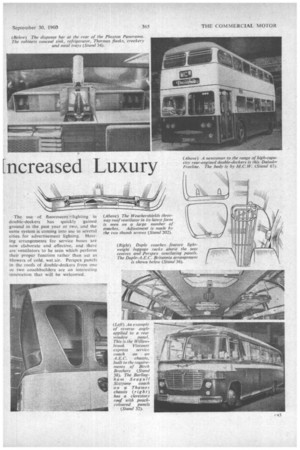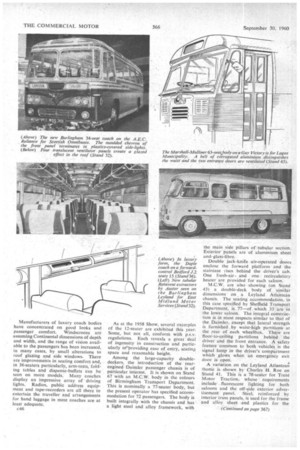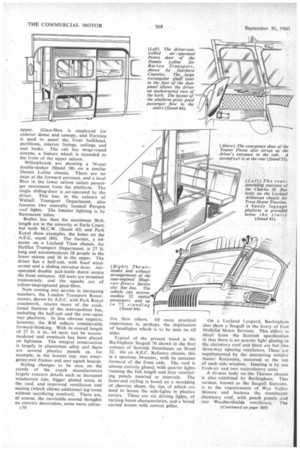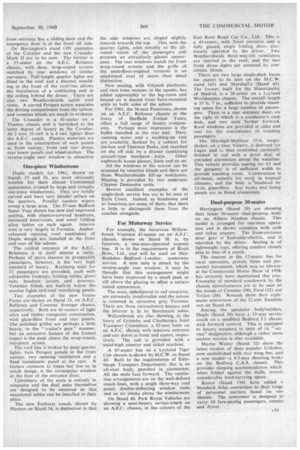High Capacity an
Page 128

Page 129

Page 130

Page 133

Page 134

Page 137

If you've noticed an error in this article please click here to report it so we can fix it.
[flu-eased Luxury
I:THOUGH there may, perhaps, be one or two trifling dissimilarities
between an exhibition of commercial motor vehicles at Earls Court and an autumn collection of haute couture in a Paris salon, the basic difference surely lies in the fact that at the former the customer is seeing something that suits him.
Certainly, so far as the passenger bodywork section is concerned, an inspection of the exhibits reveals a remarkable unanimity of thought amongst operators. The double-deckers that are going to replace existing fleets are to be maximumdimension vehicles with seating capacities of 70 or more. An intriguing feature is the manner in which the bodybuilders have managed to fit in three or four extra seats on some of the chassis we first saw two years ago.
With payload ever in the forefront of their minds, designers have made good use of every square foot of body space without in any way detracting from the convenience of -passengers. Indeed, platform and gangway layouts in general make for smooth traffic flow, particularly in double-deckers. .
The availability of aluminium alloys and plastics materials, too, has gone tar towards saving unnecessary weight• in construction.. The passenger will notice the brighter interior finish of many buses but the operator will, perhaps, value the unseen, lightweight framework even . Exhibits at Earls Court seem to indicate that the front-entrance bus, both -singleand double-deck, is generally accepted as the right vehicle for the job. Maximum vision is provided for the driver in the latest full-fronted designs, with windscreens giving wrap-round effect. Sliding or folding doors under the control of the driver are now standard features. and designers have made sure that drivers can...-sec.. the kerb at picking-up points.
The use of fluorescent lighting in double-deckers has quickly gained ground in the past year or two, arid the same system is coming into use in several cities for advertisement lighting. Heating arrangements for service buses arc now elaborate and effective, and there are ventilators to be seen which perform their proper function rather than act as blowers of cold, wet air. Perspex panels in the roofs of double-deckers from one or two coachbuilders are an interesting innovation that will be welcomed.
Manufacturers of luxury coach bodies have concentrated on good looks and passenger comfort. Windscreens are assuming Continental dimensions of depth and width, and the range of vision available to the passengers has been increased, in many cases, by small alterations to roof glazing and side windows. There are improvements in seating comfort and, in 36-seaters particularly, arm-rests, folding tables and dispense-buffets can he seen on more models. Many coaches display an impressive array of ' driving lights. Radios, public address equipment and tape-recorders are all there to entertain the traveller and arrangements for hand luggage in most coaches are at least adequate.
c46 As at the 1958 Show, several examples of the I2-seater are exhibited this year. Some, but not all, conform with p.s.v. regulations. Each reveals a great deal of ingenuity in construction and particularly in' providing ease of entry, seating space and reasonable height.
Among the large-capacity doubledeckers, the introduction of the rearengined Daimler passenger chassis is of particular interest. It is shown on Stand 67 with an M.C.W. body in the colours of Birmingham Transport Department. This is nominally a 77-seater body, but the present operator has specified accommodation for 72 passengers. The body is built integrally, with the chassis and has a light steel and alloy framework, with the main side pillars of tubular section. Exterior panels are of aluminium sheet and-glass-fibre.
Double jack-knife air-operated doors enclose the forward platform and the staircase rises behind the driver's cab. One fresh-air. and one recirculatory heater are provided for each saloon.
M.C.W. are also showing (on Stand 43) a double-deck body of similar dimensions' on a Leyland Atlantean chassis. The seating accommodation. in this case specified by Sheffield Transport Department, is 77—of which 33 are in the lower saloon. The integral construction is in most respects similar to that of the Daimler, except that lateral strength is furnished by waist-high partitions at the year of each wheelbox. There are floor-to-ceiling partitions behind the driver and the front entrance. A safety feature common to both vehicles is the signal lamp in the driver's compartment which glows when an emergency exit door is open. •
A variation on the Leyland Atlantean theme is shown by Charles H. Roe on Stand 41. This is a 78-seater for Trent Motor Traction, whose requirements include fluorescent lighting for both saloons and the off-side exterior advertisement panel. Steel, reinforced by interior truss panels, is used for the frame and alloy sheet and plastics for the
exterior panelling. Colour-impregnated glass-fibre forms the seat hacks. Two recirculatory heaters are provided for each saloon and there are 14 double sliding windows.
Walter Alexander, the Falkirk coachbuilders, are showing a 72-seater on a Leyland Titan chassis for Glasgow Transport Department on Stand 48. This is, perhaps, typical of the vehicle destined for use in congested cities. The full front gives excellent vision and the wide front entrance, with power-operated doors, will accept two passenger streams with the minimum delay. With the exception of the two banks of seats over the rear wheel-arches, all seats face forward and both saloons are heated. 'Fluorescent lighting is employed, the upper saloon being lit by six and the lower by four tubes. Interior panels are faced with Formica. • The •Park Royal Wulfrunian on Stand 55 is a 73-seater, exhibited in the colours
of Bury Transport Department. Construction in this case is in steel for the lower saloon and aluminium alloy for the upper, with aluminium and plastics exterior panelling. Access to the engine is via a detachable panel at the off-side front end, below the windscreen. Electropneumatic control is provided for the
double-folding doors. Heat-exchange units in the front of the upper saloon supply a flow of warm air to both decks.
Another version of the Guy Wulfrunian double-decker is shown by Northern Counties on Stand 44. This is a 75-seater for Lancashire United Transport. The body is of standard steel construction. with the entrance at the front and the staircase on the near side. The Deans doors are electrically operated by the driver, and both saloons are lighted by fluorescent tubes. Glass-fibre is used for window pans, front and rear domes and ticket boxes, and some Formica panelling fulfils a decorative and useful purpose. Saloons are heated by the Cave-BrowneCave system, Roe (Stand 41) arc also showing a 75seat body on the Guy Wulfrunian chassis,
of 15-ft. 4-in. wheelbase. The framework here is steel for the lower saloon and aluminium alloy for the upper. The position of the rear-ascending stairway at the front near side is'dietated largely
by the engine layout. Access to the power unit is facilitated by hingeing the front off-side part of the body, including the driver's windscreen. Fluorescent lighting is installed in both saloons and thermostatically operated shutters at the front of the upper saloon control the flow of fresh or heated air.
Among the Park Royal exhibits on
Stand 40 is a Bridgemaster body on an A.E.C. chassis with air suspension. This 72-seater has an overall height of 13 ft. 5-,1 in. yet still maintains wide, central gangways in both saloons. Double jackknife doors enclose the front entrance. The off-side staircase is of the forward ascending type. Fluorescent lighting is provided for both saloons. Steel, high. duty alloys and reinforced glass-fibre are used in the construction.
Not the least interesting features of the Northern Counties high-bridge doubledecker, shown on a Leyland P.D.3. chassis (Stand 44), are the two Perspex panels in the roof, located to light the stair-well and the rear seats. This 69-seater is of the full-front, forwardentrance type with doors 3 ft. 8 in. wide There are several plastics mouldings. both inside and outside the body, and the interior lighting is by fluorescent tubes. Headroom in the upper saloon is 5 ft. 9 in. and in the lower saloon 5 ft. ll in.
By employing a sunken gangway on the off side of the upper saloon of their 69-seat low-bridge double-decker on the Dennis Loline chassis, Northern Counties have achieved an unladen overall height of 12 ft. 5+ in. In this ease, •the construction is steel-framed for the lower saloon and aluminium alloy for the
upper. Glass-fibre is employed for exterior dome and canopy, and Formica is used to panel the front bulkhead, partitions, interior linings, ceilings and seat backs. The cab has wrap-round screens, a feature which is extended to the front of the upper saloon.
Willowbrook are showing a 74-seat double-decker (Stand 38) on a similar Dennis Loline chassis. There arc no steps at the forward entrance, and a level floor in the lower saloon assists passenger movement from the platform. The single sliding-door is air-operated by the driver. This bus, in the colours of Walsall Transport Department, also features two centrally located Perspex roof lights. The interior lighting is by fluorescent tubes.
Bodies less than the maximum 30-ft. length are in the minority at Earls Court, but both M.C.W. (Stand 43) and Park Royal show examples, the latter on the A.E.G. stand (80). The former, a 64seater on a Leyland Titan chassis, for Halifax Transport Department, is 27 ft. long and accommodates 28 people in the lower saloon and 36 in the upper. The driver has a half-cab, with fixed windscreen and a sliding entrance door. Airoperated double jack-knife doors secure the front entrance. All seats are mounted transversely, and the squabs are of colour-impregnated glass-fibre.
Now coming into service in increasing numbers, the London Transport Routemaster, shown by A.E.C. with Park Royal coachwork, retains many of, the traditional features of the metropolitan bus, including the half-cab and the ever-open rear platform. In less obvious respects, however, the RM reflects considerable forward-thinking. With its overall length of 27 ft. 6 in., 64 seats can be accommodated and emphasis has been placed on lightness. The integral construction is largely in aluminium alloy and there are several plastics panels as, for example, in the bonnet top, rear emergency-exit frames and seat squab boards.
Styling changes to be seen on the stands of the coach manufacturers largely concern details such as increased windscreen size, bigger glazed areas in the roof, and improved ventilation and seating (which allows additional leg-room without sacrificing comfort). There are, of course, the inevitable second thoughts on exterior decoration, some more attrac c50 tive than others. Of more practical importance is, perhaps, the duplication of headlights which is to be seen on all sides.
Typical of the present trend is the Burlingham Seagull 70 shown in the fleet colours of Scottish Omnibuses on Stand 32. On an A.E.C. Reliance chassis, this is a spacious 34-seater, with its entrance forward of the front axle. The roof is almost entirely glazed, with quarter lights running the full length and four ventilating panels inserted at intervals. The front-end styling is based on a moulding of chevron shape, the tips of which are used to house the side-lights in plastics covers. There are six driving lights, of varying beam characteristics, and a broad curved screen with central pillar.
On a Leyland Leopard, Burlingham also show a Seagull in the livery of East Midland Motor Services. This differs in detail from the Scottish specification in that there is no quarter light glazing in the clerestory roof and there are but two three-way opening ventilators. These are supplemented by the interesting tubular Auster Rotavents, mounted at the top of each side window. Heating is by fresh-air and two recirculatory units."
A 41-seat body on the Thames chassis is also exhibited by Burlingham: This version, known as the Seagull Sixtyone, is to the requirements of Wye Valley Motors and features the translucent clerestory roof, with peach panels and two Weathershields ventilators. The front entrance has a sliding door and the emergency door is at the front off side.
On Harrington's stand (39) examples of the Cavalier and the new Crusader Mark II are to he seen. The former is a 37-seater on the A.E.C. Reliance chassis, with deep, wrap-round screens matched by rear windows of similar curvature. Full-length quarter lights are fitted in the roof and a discreet moulding in the front of the roof-line allows the installation of a ventilating unit in the ceiling behind the driver. 'there are also two Weathershields uplift roof vents, A curved Perspex screen separates the driving compartment from the saloon, and venetian blinds are much in evidence.
The Crusader is a 4I-seater • on a Thames chassis and is furnished to the same degree of luxury as the Cavalier. At 2 tons j0 cwt. it is 4 cwt. lighter than the A.E.C. coach. Plastics materials are used in the construction of such panels as front canopy, front and rear dome, rear lower panels and wheel-arches. The reverse-angle rear window is attractive.
One-piece Windscreens
Duple models for 1961, shown on Stands 35 and 36, are most obviously notable for their almost Continental appearance, created by large and virtually one-piece windscreens. They are boldly curved and have very slender pillars on the quarters. Parallel tandem wipers sweep a large area. The 37-seat Bedford Super Vega shown has new and improved seating, with plastics-covered headrests, increased knee-room, and small folding alloy tables on each squab. Interior trim is very largely in Formica. Ambercoloured opening roof ventilators of Duple design are installed at the front and rear of the saloon.
The central entrance of the A.E.C. Britannia is in itself almost a rarity. Perhaps of more interest to prospective passengers, however, is the very high standard of luxury. Reclining seats for 32 passengers are provided, each with adjustable footrests, folding tables, glove nets, headrest Covers and armrests. Venetian blinds are built-in below the quarter lights and roof ventilating panels.
Two examples of the new Yeates Fiesta are shown on Stand 33, on A.E.C. Reliance and Commer Avenger chassis, respectively. Both are 41-seaters of light alloy and timber composite construction, with glass-fibre front and rear panels. The polished grilles are perhaps a little heavy, in the "traitor's gate" manner, but an attractive feature of the frontal aspect is the peak above the wrap-round, two-piece screen.
The roof line is broken by deep quarter lights, twin Perspex panels in the front canopy, two opening ventilators and a fixed translucent panel at the rear. A feature common to buses but less so in coach design, is the rectangular window at the foot of the entrance door.
Upholstery of the seats is entirely in moquette and the dual seats themselves are designed to be removed so that occasional tables can be installed in their place.
The new Embassy coach, shown by Plaxton on Stand 34, is distinctive in that the side windows are sloped slightly inwards towards the top. This, with the quarter lights, adds notably to the allround vision of the passengers and presents an attractively glazed appearance. The rear windows match the front wrap-round screens and the grille of the underfloor-engined versions is an unadorned oval of snore than usual distinction.
New seating, with Vitaweb platforms and twin knee recesses in the squabs. has added appreciably to the leg-room and heated air is ducted from facia-mounted units to both sides of the saloon.
For 1961, the 36-seat Panorama, shown on an A.E.C. Reliance chassis in the livery of Sheffield United Tours, offers a full range of luxury compon ents. Perhaps most impressive is the buffet installed at the rear end. Here, running water and a washing-up sink are available, flanked by a cabinet for ice-box and Thermos flasks, and matched on the off side by a drawer containing aircraft-type luncheon trays. Other cupboards house glasses, linen and so on.
All the windows in the saloon can be screened by venetian blinds and there are three Weathershields lift-up ventilators. Heating is provided by two underseat Clayton Dewandre units.
Several excellent examples of the single-deck service bus are to be seen at Earls Court. Indeed, so handsome and so luxurious are some of them, that there is little to distinguish them from the coaches alongside.
For Motorway Service
For example, the luxurious Willowbrook Viscount 41-seater on an A.E.C., chassis, shown on Stand 38, is, by function, a one-man-operated express bus. It is to the requirements of Birch Bros., Ltd., and will be used on their Rushden Bedford London motorway service. A new note is struck by the reverse-angle rear window: it may be thought that this arrangement might have been improved by a small peak or sill above the glazing to offset a certain naked appearance.
The seats, upholstered in red moquette, are extremely comfortable and the saloon is trimmed in attractive grey Formica. There are three. recirculatory heaters and the interior is lit by fluorescent tubes.
Willowbrook are also showing, in the livery of Grimsby and Cleethorpcs Joint Transport Committee, a 42-seat, body on ,an A.E.C. chassis with separate entrance and exit doors at front and centre, respectively. The cab is provided with a waist-high counter and ticket machine.
A 47-seater bus on a Leyland Tiger Cub chassis is shown by M.C.W. on Stand 43. Built to the requirements of Edinburgh Transport Department, this is an all-steel body, panelled in aluminium. All the seats face forward. The ventilation arrangements are on the well-defined coach lines, with a single three-way roof panel, double-deflecting window vents and an air intake above the windscreens.
On Stand 40, Park Royal Vehicles are showing a semi-luxury service-coach on an A.E.C. chassis, in the colours of the
East Kent Road Car Co., Ltd. This is a 41-seater, with front entrance and a fully glazed, single folding door, electrically operated by the driver. Two Weathershields three-way-lift ventilators are inserted in the roof, and the two front dome lights are screened by concertina blinds.
There are two large single-deck buses for export to be seen on the M.C.W. stand (43) and Marshall's (Stand 45). The former, built for the Municipality of Madrid, is a 28-seater on a Leyland Worldmaster chassis. The overall length is 35 ft. 7 in., sufficient to provide standing space for a large number of passengers. There is a rear entrance door, on the right of which is a conductor's cash desk, and two exits farther forward. Roof windows are provided at sides and rear for the convenience of standing passengers.
The Marshall-Mulliner 35-ft. singledecker, on a Guy Victory, is destined for Lagos and is thus somewhat exotically finished in red with a great deal of extruded aluminium about the waistline. This vehicle provides seating for 63 and the gangway is of sufficient width to provide standing room. Construction is all-metal, suitable for work in tropical climates, and the body is insulated by 1 glass-fibre. Seat backs and lining panels are in fluted aluminium.
Dual-purpose 30-seater
Harrington (Stand 39) are showing their latest 30-seater dual-purpose body on an Albion Nimbus chassis. This model is arranged for one-man operation and is shown complete with cash and ticket counter. The front-entrance door gear is hydraulic-electric, and is operated by the driver. Seating is of lightweight type, offering comfort closely akin to that•of a coach.
The interest in the I2-seater bus for rural operation, private hires and personnel movement, which was so obvioui at the Commercial MotOr Show of 1958. has certainly been maintained this year. Examples of standard coachwork by the chassis manufacturers are to be seen on the stands of Commer (90), Ford (92) and Trojan (58). Renault show their eightseater conversion of the 12-cwt. Estafette van on Stand 66.
Among the specialist bodybuilders, Duple (Stand 36) have a 15-seat serviu coach on a modified Bedford J.2 chassis with forward control. This is equipped to luxury standard in spite of its "service" designation, although a rather more austere version is also available.
Martin Walter (Stand 52) show the latest version of their popular Utilahus. now embellished with rear wing fins, and a new model—a 4-5-seat shooting brake on the Bedford C.A.S. chassis. This provides sleeping accommodation which. when folded against the walls, reveals considerable load-carrying space, Kenex (Stand 134) have added a Standard Atlas conversion to their range of personnel carriers based on van chassis. The newcomer is designed to carry 10 fare-paying passengers, courier and driver. ,
























































































































































































